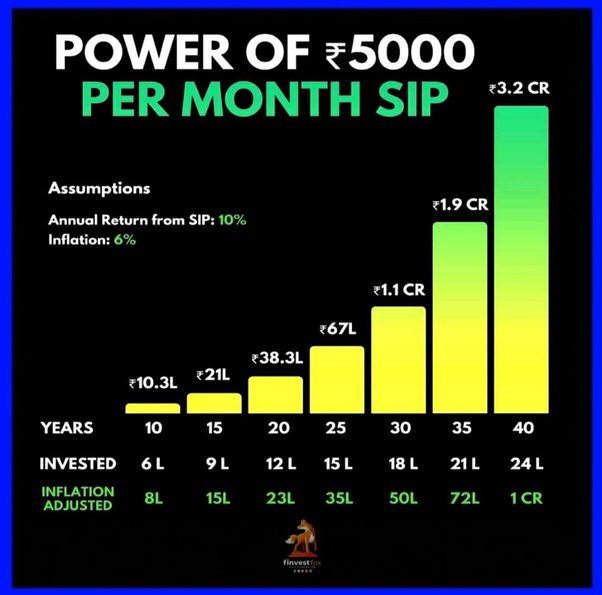SIP (Systematic Investment Plan)

A Systematic Investment Plan (SIP), more popularly known as SIP, is a facility offered by mutual funds to the investors to invest in a disciplined manner. SIP facility allows an investor to invest a fixed amount of money at pre-defined intervals in the selected mutual fund scheme. The fixed amount of money can be as low as Rs. 500, while the pre-defined SIP intervals can be on a weekly/monthly/quarterly/semi-annually or annual basis. By taking the SIP route to investments, the investor invests in a time-bound manner without worrying about the market dynamics and stands to benefit in the long-term due to average costing and power of compounding.
2.Benefits of SIP

SIPs offer a broad basket of benefits to investors across age groups and risk profiles. Following are some of the most prominent benefits of SIP plans:
- Rupee-cost averaging Rupee-cost averaging is one of the most prominent benefits of SIPs because it eliminates the need to time the market. Investors try to time the market by investing money based on momentary market movements and due to lack of expertise, can end up losing money in the process. SIPs take out the guesswork since it involves investing a fixed amount at predetermined intervals, regardless of the market’s position. When the markets, and consequently a mutual fund’s NAV, are low, you’re allotted a greater number of units for the amount you invest, on the other hand, you’re allotted fewer units when the markets are at a peak. Over the long term, this reduces your average cost per allotted unit. For instance, say you’ve decided to invest ₹5,000 via SIP each month for the next 5 months. Here’s how rupee-cost averaging will work in your favor for this investment:
| Asset Classes | 1-year Returns(%)* | NAV | Units [Contribution/NAV] | NAV | Units with Lumpsum |
|---|---|---|---|---|---|
| Jan | 5,000 | 100 | 50 | 100 | 250 |
| Feb | 5,000 | 98 | 51.02 | – | – |
| Mar | 5,000 | 96 | 52.08 | – | – |
| Apr | 5,000 | 102 | 49.01 | – | – |
| May | 5,000 | 100 | 50 | – | – |
| Total | 25,000 | 491 | 252.11 | 100 | 250 |
Your average NAV cost per unit comes to 98.2 [491 ÷ 5], thanks to rupee-cost averaging. If you had invested a lumpsum of ₹25,000 in January, your NAV cost per unit would have been ₹100. You’d also have been able to purchase only 250 units (2.11 fewer units, i.e., 25,000 ÷ 100 = 250 units) if you had invested a lumpsum amount.
The value of the investment would also have been different. If you had invested ₹25,000 in January, your investment’s value in May would have been ₹25,000. However, because of rupee-cost averaging, your investment’s value in May with SIPs would be ₹25,211 [i.e., 252.11 units x ₹100 NAV].
- Professional management Mutual funds are managed by experts that have a proven track experience as portfolio managers. They also have a team of research analysts at their disposal that monitor the markets and gauge investment opportunities. Since your SIP investments are investments in mutual funds, you benefit from the fund manager’s expertise. This is especially important for someone who doesn’t understand financial jargon or the markets. Instead of risking your capital, let an expert manage your money. In essence, SIPs allow you to outsource investment expertise to a fund manager who manages the mutual fund’s assets to optimize the returns for its investors. It’s a win-win.
- Financial Discipline A growth in income may trigger some to spend on upgrading their lifestyle. The wiser ones tend to do the reverse; they spend what’s left after investing. SIPs can help inculcate this discipline because you’re committing to investing a fixed amount each month. You don’t need to make an extra effort for monthly contributions either. The money is automatically debited from your registered account each month. Over time, the small contributions grow into a substantial amount because of compounding.
- Power of compounding The returns on your SIP investment, just like other mutual funds, benefit from compounding. To get some context on how powerful compounding can be, think of the returns in absolute terms. Here’s an example to illustrate the power of compounding. Say you invest ₹1,00,000 per annum. Assuming a 12% rate of return, here’s how much you’ll earn based on how long you continue investing for:


Hi, this is a comment.
To get started with moderating, editing, and deleting comments, please visit the Comments screen in the dashboard.
Commenter avatars come from Gravatar.